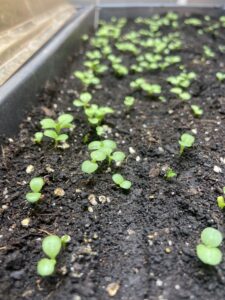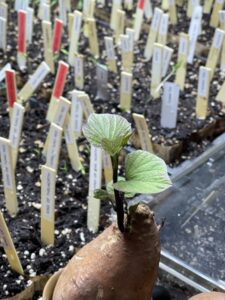While it’s still chilly outside, before the business swings back into the busy season, we start sowing our seeds. First, we make a master schedule of plant dates for each variety that we want to grow. This is based off of the predicted last frost date. Then, we cross-reference the information about gemination conditions on the back of our seed packets with trusted internet sources to narrow down their exact requirements. Julie is continually fighting her frustration with forums and social media: where people give novice gardeners advice for growing seedlings as if each type of plant requires the same environment. This is simply not that case. In fact, only some seeds need light to germinate, temperatures can vary from 40-80 degrees, and some seeds need to be pre-soaked?
Some of the first plants we sow are common vegetables. This includes onions, tomatoes, peppers and eggplants. Meanwhile, watermelon and squashes are a few of the last plants that we start in flats for the season. All of our bean varieties, along with the beets and radishes, go directly into the soil once it gets warm enough.
So far we have started the wildflowers, which we put outside for the past few months to stratify. If you aren’t familiar, stratification replicates an important part of the growth cycle, allowing seeds that have a hard coating to germinate with more success. This year we stuck a bunch of varieties outside, even those that didn’t say stratification was necessary, and we received very positive results (who knew you’d like a chill, Golden Marguerite–Anthemis?!). After just a few days under the grow lights some of the perennials that have never sprouted before are germinating! Over the next few months these seedlings will live under timed lights, which turn on for twelve hours a day, and plastic domes, which help produce a greenhouse effect that reduces that amount of watering we have to do.
Seeing the wildflowers thriving is just another reminder that the recommendations you get are not always going to work. In fact, the general seed starting information that you find online often does not work for all plant varieties. Over the years, Julie has learned how to work around this. She makes sure to keep detailed notes of what works each year so that she can replicate successful methods. From experience she has learned how to cater to each individual plant: only watering certain ones on certain days, and even setting up fans in the basement to replicate wind to make the plants stronger and resist fungal diseases.
We have also started the sweet potatoes for this coming summer by partially submerging mature potatoes in water after slicing them in half. After a few days they should start growing roots. Then, they start to send up shoots, called slips, as pictured below.
Throughout January, February and March we plant something almost every week. As the seedlings get larger, they will eventually be moved into our enclosed pool while they await the last frost date. We are somewhat limited by the amount of space we have in the basement to care for our seedlings, as we don’t want Julie’s family to feel that the garden is overtaking their house and stage a coup of sorts. Yet somehow the amount of vegetation on the property, both inside and out, seems to magically increase every time we turn around. Julie swears that the discounted plants she feels compelled to buy have nothing to do with it.
But more importantly, we are staggering the sow dates of our popular plants. This staggered planting lengthens the time of harvest, which is better for our guests since they can experience a wider variety of our produce when they visit. They also even out the amount of work we must do as the weeks progress. We are also working on planting only what we need. This includes more peppers and Malabar, which is like a tropical version of common spinach. We often include these vegetables in our breakfast dishes.
More recently Julie has been experimenting with rotational cover crops. For instance, we laid down a thick layer of rye over the fields. This short crops fibrous root system helps aerate the soil and increase the exchangeable potassium at the soil surface. Having something planted in the fields also protects the soil from wind and water erosion.
If you are interested in how we manage our wonderful hodgepodge of greenery, or want to taste some of our oddball vegetables in a tasty breakfast, please come and visit Goldberry! Alternatively, you can stop by in the summer months to see our seedlings all grown up and shop our market stand for fresh produce daily. We are always so excited to share with seasoned and novice gardeners alike, and we gladly share every secret we have learned in our eleven growing seasons. ~ Sydney Moore

